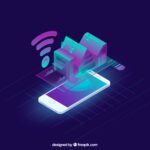In the present age of digits, What is ICT is commonly used and it has been changing our way of living, learning and doing business. However, what does this term mean? And why is it important in our daily life? This article will discuss about Information and Communication Technology (ICT) in terms of its definition, development, components.
Thank you for reading this post, don't forget to subscribe!
Introduction to ICT
ICT which is an abbreviation for Information and Communication Technology is defined as a wide range of technologies. These include different types of tools systems and applications that enable communication storage retrieval and processing data.
Understanding the Definition of ICT
To understand what is meant by ICT one must have an idea about all the different kinds technology . It stands for Information and Communication Technology where information technology (IT) is integrated with telecommunications processing management.
It involves various forms hardware software networks services that allow people or organizations to communicate access or modify data conveniently. To put it simply everything falls under computers smartphones internet communication networks databases software applications among others
Evolution of ICT: From Origins to Modern Applications
ICT refers to its roots and shows how technology has advanced. In the beginning, ICT was modest when simple computers were invented together with basic telecommunication systems. These initial technologies acted as a foundation for other complex innovations which came later.

Along with the increase in computing power as well as expansion of telecommunication networks; ICT kept changing. The personal computer introduction followed by internet development are examples. The way we get, share and handle information was completely changed forever by these improvements.
Importance of ICT in Today’s World
We cannot overstate the importance of Information and Communication Technology (ICT) today. It plays a critical role in shaping communication methods, learning processes, working conditions and business transactions. Here are some areas where it matters most:
ICT in Education
- Access to Information: Through ICT students and teachers are given opportunity to tap into the vast amounts of knowledge.

Online databases, digital libraries and educational website every topic allowing learners more easily thus enhancing research work.
- Interactive Learning Multimedia presentations and virtual simulations are some of the ICT tools that improve learning.
They make lessons more fun and engaging. For example, if you have an Interactive whiteboard, tablets or educational apps students to interact with content in dynamic ways.
ICT in Business
- Efficient Communication: ICT promotes seamless communication within and among organizations through email, instant messaging (IM), video conferencing (VC) as well as collaboration tools among others.

The use of these technologies ensures that communication is in real-time which encourages teamwork and quick decision making.
- Data Management and Analysis For businesses to succeed they need access to accurate information. About themselves and their environment which can be achieved by adopting ICTs in data collection, storage analysis etcetera. Such insights help them know how best they can serve customers. While also staying ahead of competitors who may take advantage of market trends.
ICT in Healthcare
- Telemedicine and Remote Consultations: Mobile health apps telemedicine platforms videoconferencing systems are among the ICT remote consultations between patients.
This allows people seeking medical care receive necessary advice diagnosis treatment. Recommendations without necessarily having to go hospitals physically thereby increasing accessibility especially for those living rural areas or underserved regions.
- Electronic Health Records (EHRs): ICT helps to move from paper-based medical records to electronic health records (EHRs).
EHR systems allow doctors to access patient data safely, simplify clinical workflows and improve care coordination between different healthcare settings.
Components of ICT
ICT (Information and Communication Technology) comprises several essential components that work together to facilitate the exchange of information. Here are the key components of ICT:
1. Hardware:
Hardware comprises all the physical devices used for inputting, processing, storing and outputting data. This includes computers, servers, laptops, tablets, smartphones, routers, switches as well as peripheral devices like printers, scanners and storage drives.
2. Software:
Software refers to programs or applications which allow users to do different things on hardware devices. They include operating systems (e.g., Windows, macOS or Linux), productivity software (e.g., Microsoft Office or Google Workspace). Specialized applications (e.g., graphic design software or accounting software) and custom-developed software solutions designed for specific business requirements.

3. Telecommunications:
Telecommunications technologies enable transmission or exchange of information across long distances. These involve wired communication technologies such as telephone lines; fiber-optic cabl. Ethernet networks; wireless communication technologies like Wi-Fi; cellular networks; satellite communication; Bluetooth among others.
4. Data Management Systems:
Information management systems include databases, storage solutions, and tools for data analysis. All these enable companies to store, retrieve, explore, and control large amounts of information in a smarter way. This comprises relational database management systems (RDBMS), data warehouses, data lakes, data visualization tools as well as business intelligence platforms.
Role of ICT in Facilitating Communication
ICT (Information and Communication Technology) plays a vital role in facilitating communication by providing individuals. And organizations with the tools and platforms to exchange information efficiently and effectively. Here’s how ICT facilitates communication:
1. Instant Messaging and Email ICT
It enables real-time communication through instant messaging platforms and email services. Individuals can send and receive messages instantly, regardless of geographical distance, allowing for quick and convenient communication.
2. Video Conferencing:
Face-to-face interaction is also supported by ICT through video conferencing platforms like Zoom, Microsoft Teams or Google Meet. These allow individuals or groups to hold virtual meetings where they share ideas in real-time while working together on projects thus fostering closer relationships among them.
3. Voice Communication:
Voice communication on the other hand is enhanced by ICT using Voice over Internet Protocol (VoIP) technology together with digital telephony systems. Through this method voice calls can be made over the internet which cuts down communication costs besides linking people from different parts of the world seamlessly both individually and corporately.
Future Prospects of ICT
The future prospects of ICT (Information and Communication Technology) hold immense promise, with emerging technologies poised to revolutionize various industries and transform the way we live and work. Here are some key trends and developments shaping the future of ICT:
1. Artificial Intelligence (AI):
Artificial intelligence is about to have a huge impact on information and communications technology in the future, because it will make it possible for machines to do things that would normally require human intelligence like understanding natural language, recognizing images and making decisions.
It is expected that AI systems will automate more tasks by leveraging automation; companies are also likely going personalize services further based on predictive capabilities provided by such systems.
2. Internet of Things (IoT):
The internet of things (IoT) refers to the concept of connecting any device with an on/off switch to the Internet as well as each other thus enabling them collect data, share it and analyse it. In future years there will be a greater presence of these everyday objects connected via IoTs within homes, cities & industries resulting into smarter home systems; self-driving cars; wearable devices etcetera.
3. 5G Technology:
5G technology when fully rolledout can transform connectivity since it offers faster speeds for transferring data packets between devices being used over long distances apart from low latency which enhances real-time experience creation among users plus wider network capacity that can accommodate many more connections simultaneously than current 4G networks can handle.
With this in mind advanced applications such as augmented reality (AR), virtual reality (VR), remote surgery and self driving vehicles could work better only if supported by 5G networks otherwise they may not function properly due to slower bandwidth provided by previous generations. The widespread adoption of 5G infrastructure brings about limitless opportunities.
4. Blockchain Technology:
Blockchain has gained popularity lately thanks its distributed ledger system which ensures transparency at every stage supply chain management process thus making transactions secure and trustworthy all times without need third parties like banks or governments intervening unnecessarily.
Additionally healthcare industry can make use blockchain technology to store patient records securely so that they are easily accessible from anywhere by authorized personnel whenever required thus reducing medical errors caused through lack accurate information about history previous treatments received etcetera
Conclusion:
To sum up, ICT or Information and Communication Technology can be described as a system consisted of different types of equipment such as hardware and software along with telecommunication infrastructure used for management and processing of data which enable us to communicate easily, get information quickly and conduct business electronically.
Throughout its history until present day, this technology has played a significant role in spurring innovation as well as improving connections among people from different parts of the world while at the same time changing many sectors both within societies and across industries. Since we live in an era where almost everything is connected; therefore without appreciating what ICT means one cannot fully exploit its benefits towards encouraging cooperation.
Ultimately, ICT is the basis upon which we will build tomorrow’s communication network unbounded by space barriers today’s knowledge society whose success factors are easy availability plus limitless growth opportunities.



Comments are closed